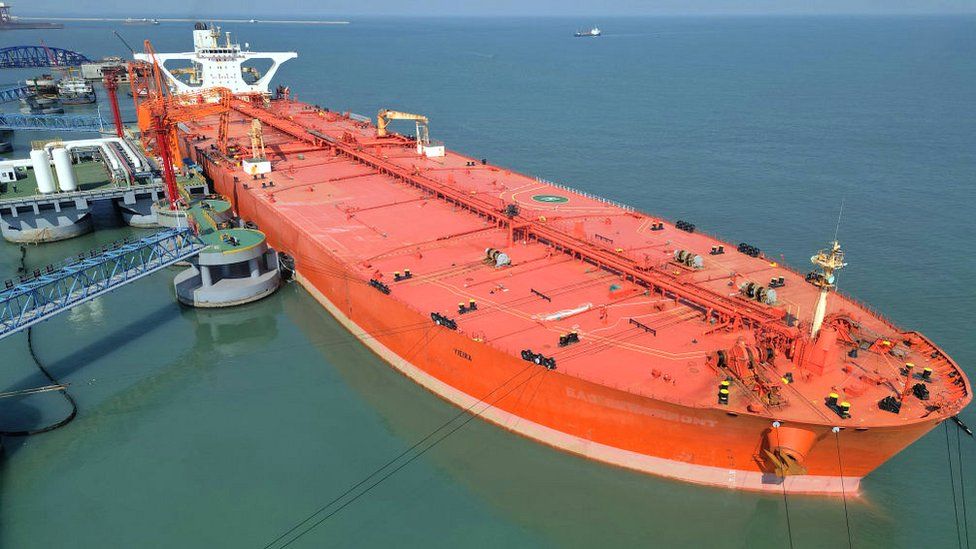Ukraine crisis: Who is buying Russian oil and gas?
- Published

India's oil purchases from Russia have risen sharply, despite efforts by Ukraine and its allies to persuade countries around the world to distance themselves from Russia.
Indian Prime Minister Narendra Modi met Ukrainian President Volodymyr Zelensky at the recent G7 summit in Japan, but there was little detail of what was discussed.
Western nations have cut Russian oil imports, and want to limit the amount of revenue Moscow earns from selling oil elsewhere.
How much Russian oil is going to Asia?
India's imports of Russian oil rose from a very low base at the start of 2022, increasing significantly throughout that year.
Russian oil now accounts for nearly 20% of India's annual crude imports, up from just 2% in 2021, according to Indian state-controlled lender Bank of Baroda.
India's purchases of seaborne crude from Russia have surpassed those by China.
But China also gets nearly 800,000 barrels per day via a pipeline from Russia (in addition to imports by sea), although this is currently believed to be at or near full capacity.
India started buying up Urals crude selling at a discount after the invasion of Ukraine last February.
But in recent months, its oil refiners have also shown increasing interest in Russia's ESPO blend (East-Siberia Pacific Ocean).
China's seaborne imports of Russian oil did increase in 2022, but then fell back before increasing again in the latter part of the year and early this year.
Other countries have also taken advantage of discounted Russian crude.
Turkey has bought significantly more, and so has Bulgaria, which has an exemption from the EU ban on Russian oil to allow it to continue to import it by sea.
Pakistan has also struck a deal with Russia to purchase discounted oil.
But these do not match the quantities imported by India and China.
Cheaper oil is driving the flow to Asia
Following its invasion of Ukraine, Russia had fewer buyers, as some foreign governments and companies decided to shun its energy exports.
At one point last year, Russian Urals crude was more than $30 a barrel cheaper than Brent crude (the global benchmark).
In December 2022, G7 and EU leaders introduced a price cap plan aimed at limiting the revenue Russia earns from its oil exports, by trying to keep it below $60 a barrel.
The EU also stopped imports of Russian oil by sea, and banned the import of refined oil products from Russia.
Russia's oil exports in April have gone up by volume compared with a year ago, but its revenues have fallen by 27%, according to estimates by the International Energy Agency.
After the invasion of Ukraine, the US voiced its unhappiness about India buying up Russian oil, although it has made clear that it accepts that India can source crude from Russia.
There have also been concerns that refined fuels made from Russian oil are being sold on to the US and EU. There's been a significant increase in EU imports of diesel and jet fuel from India.
The Indian government has defended its continuing purchases of crude from Russia, saying it has to source oil from where it is cheapest.
India's refineries have faced a challenge trying to finance these purchases because sanctions on Russian banks are affecting payment transactions.
Currently, Indian refiners are continuing to use dollars to buy Russian oil, but have been looking for alternative ways to pay.
China's state-owned oil enterprises are increasingly using the Chinese renminbi, rather than the dollar, to finance oil purchases.
How much Russian gas goes to Asia?
China imports most of its gas via pipeline from Central Asia - Turkmenistan is currently the largest supplier.
But a new pipeline, known as Power of Siberia, is due to be completed later this decade, and could make Russia China's biggest supplier of gas. Some reports say the two countries are close to agreeing to start construction next year.
And China has signed new deals to transport Russian LNG (liquified natural gas) by sea via the Arctic. There was a noticeable increase in 2022 in Chinese LNG imports from Russia, taking them to record levels at one point.
Nearly 50% of India's total gas requirements come from abroad, but very little is from Russia and most comes from the Gulf states.